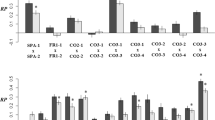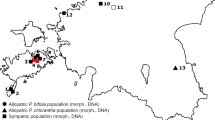Abstract
The article is devoted to quantitative characteristics of assortative mating (R) as indicator of “reinforcement” in 12 hybrid zones between chromosomal races of the common shrew, Sorexaraneus L. The Wahlund effect in hybrid population and its potential reduction are examined. In hybrid zones with heterozygotes CIV, CV, and RIV, the R index varies within 0.23–0.59. In hybrid zones with more complex heterozygotes (RVI, CIX–CXI), it exceeds 0.82. Gene flow in the hybrid zone is interrupted at R > 0.99. Assortative mating reduces gene flow and also maintains genotype stability in hybrid populations.




Similar content being viewed by others
REFERENCES
Baker, R.J. and Bradley, R.D., Speciation in mammals and the genetic species concept, J. Mamm., 2006, vol. 87, no. 4, pp. 643–662.
Barton, N.H. and Hewitt, G.M., Analysis of hybrid zones, Ann. Rev. Ecol. Syst., 1985, vol. 16, pp. 113–148.
Bearhop, S., Fiedler, W., Furness, R.W., et al., Assortative mating as a mechanism for rapid evolution of a migratory divide, Science, 2005, vol. 310, pp. 501–504. https://doi.org/10.1126/science.1115661
Beysard, M., Krebs-Wheaton, R.K., and Heckel, G., Tracing reinforcement through asymmetrical partner preference in the European common vole Microtus arvalis,BMC Evol. Biol., 2015, vol. 15, pp. 170–181.
Bímová, B.V., Macholán, M., Baird, S.J.E., et al., Reinforcement selection acting on the European house mouse hybrid zone, Mol. Ecol., 2011, vol. 20, pp. 2403–2424.
Borisov, Yu.M., Kriscshuk, I.A., Cherepanova, E.V., et al., Chromosomal polymorphism of populations of the common shrew, Sorex araneus L., in Belarus, Acta Theriol., 2014, vol. 59, no. 2, pp. 243–249.
Borodin, P.M., Chromosomes and speciation, in Biosphere Origin and Evolution, Dobretsov, N., Kolchanov, N., and Rozanov, A., Eds., New York: Springer-Verlag, 2008, pp. 315–325.
Brünner, H. and Hausser, J., Genetic and karyotypic structure of a hybrid zone between the chromosomal races Cordon and Valais in the common shrew, Sorex araneus,Hereditas, 1996, vol. 125, pp. 147–158.
Brünner, H., Lugon-Moulin, N., and Hausser, J., Alps, genes, and chromosomes: their role in the formation of species in the Sorex group (Mammalia, Insectivora), as inferred from two hybrid zones, Cytogenet. Genome Res., 2002, vol. 96, pp. 85–96.
Bulatova, N., Jones, R.M., White, T.A., et al., Natural hybridization between extremely divergent chromosomal races of the common shrew (Sorex araneus, Soricidae, Soricomorpha): hybrid zone in European Russia, J. Evol. Biol., 2011, vol. 24, no. 3, pp. 573–586.
Cherepanova, E.V., Krivonogov, D.M., Shchegol’kov, A.V., et al., The formation of contact zones between chromosomal races of the common Shrew (Sorex araneus, Soricomorpha) in the Volga Basin, Zool. Zh., 2018, vol. 97, no. 6, pp. 723–734.
Coyne, J.A. and Orr, H.A., Speciation, Sunderland: Sinauer Associates, 2004.
Crow, J.F. and Felsenstein, J., The effect of assortative mating on the genetic composition of a population, Eugen. Q., 1968, vol. 15, no. 2, pp. 85–97. https://doi.org/10.1080/19485565.1968.9987760
Crow, J.F. and Kimura, M., An Introduction to Population Genetics Theory, New York: Harpers and Row, 1970.
Dehnel, A., The biology of breeding of common shrew S. araneus L. in laboratory conditions, Ann. Univ.Curie-Skłodovska, 1952, vol. 6, pp. 359–376.
Fredga, K., Reconstruction of the postglacial colonization of Sorex araneus into northern Scandinavia based on karyotype studies, and the subdivision of the Abisko race into three, Russ. J. Theriol., 2007, vol. 6, no. 1, pp. 85–96.
Fredga, K. and Narain, Y., The complex hybrid zone between the Abisko and Sidensjö chromosomal races of Sorex araneus in Sweden, Biol. J. Linn. Soc., 2000, vol. 70, pp. 285–307.
Grigoryeva, O.O., Borisov, Yu.M., Stakheev, V.V., et al., Genetic structure of the common shrew Sorex araneus L. 1758 (Mammalia, Lipotyphla) in continuous and fragmented areas, Russ. J. Genet., 2015, vol. 51, no. 6, pp. 607–618.
Hedrick, P.W., Genetics of Populations, Boston: Science Books Int., 1983.
Jadwiszczak, K.A. and Banaszek, A., Fertility in the male common shrews, Sorex araneus, from the extremely narrow hybrid zone between chromosomal races, Mamm. Biol., 2006, vol. 71. 5, pp. 257–267.
Jiggins, C.D. and Mallet, J., Bimodal hybrid zones and speciation, Trans. Ecol. Evol., 2000, vol. 15, pp. 250–255.
Jones, R.M. and Searle, J.B., Mapping of course of the Oxford–Hermitage chromosomal hybrid zone in the common shrew Sorex araneus—a GIS approach, Mammalia, 2003, vol. 87, no. 2, pp. 193–200.
Li, C.C., First Course in Population Genetics, Pacific Grove, CA: Boxwood Press, 1976.
Mayr, E., Animal Species and Evolution, Harvard: Harvard Univ. Press, 1963.
Moska, M., A hybrid zone between the chromosomal races Łgucki Młyn and Popielno of the common shrew in north-eastern Poland: preliminary results, Acta Theriol., 2003, vol. 48, pp. 441–455.
Narain, Y. and Fredga, K., A hybrid zone between the Hällefors and Uppsala chromosomal races of Sorex araneus in central Sweden, Hereditas, 1996, vol. 125, pp. 137–145.
Narain, Y. and Fredga, K., Spermatogenesis in common shrews, Sorex araneus, from a hybrid zone with extensive Robertsonian polymorphism, Cytogenet. Cell Genet., 1998, vol. 80, pp. 158–164.
Noor, M.A., Speciation driven by natural selection in Drosophila,Nature, 1995, vol. 375, pp. 674–675.
Orlov, V.N., Borisov, Yu.M., Cherepanova, E.V., Grigor’eva, O.O., Shestak, A.G., and Sycheva, V.B., Narrow hybrid zone between Moscow and Western Dvina chromosomal races and specific features of population isolation in common shrew Sorex araneus (Mammalia), Russ. J. Genet., 2012, vol. 48, no. 1, pp. 70–78.
Orlov, V.N., Borisov, Yu.M., Cherepanova, E.V., and Milishnikov, A.N., Assortative mating in the hybrid zones of the common shrew (Sorex araneus, Mammalia) chromosomal race West Dvina, Dokl. Biol. Sci., 2013a, vol. 451, no. 1, pp. 217–220.
Orlov, V.N., Sycheva, V.B., Cherepanova, E.V., and Borisov, Yu.M., Craniometric differences between karyotypic races of the common shrew Sorex araneus (Mammalia) as a result of limited hybridization, Russ. J. Genet., 2013b, vol. 49, no. 4, pp. 417–427.
Pavlova, S.V. and Shchipanov, N.A., A hybrid zone between the Kirillov and Petchora chromosomal races of the common shrew (Sorex araneus L., 1758) in northeastern European Russia: a preliminary description, Acta Theriol., 2014, vol. 59, pp. 415–426.
Peakall, R. and Smouse, P.E., GenAlEx V6: genetic analysis in Excel. Population genetic software for teaching and research, Mol. Ecol. Notes, 2006, vol. 6, no. 1, pp. 288–295.
Polyakov, A., White, Th., Jones, R., et al., Natural hybridization between extremely divergent chromosomal races of the common shrew (Sorex araneus, Soricidae, Soricomorpha): hybrid zone in Siberia, J. Evol. Biol., 2011, vol. 24, pp. 1393–1402.
Shchipanov, N.A. and Pavlova, S.V., Multilevel subdivision in the araneus species group of the genus Sorex: 1. Chromosomal differentiation, Zool. Zh., 2016a, vol. 95, no. 2, pp. 216–233.
Shchipanov, N.A. and Pavlova, S.V., Evolutionary and taxonomic differentiation of shrew species in the “araneus” group of the genus Sorex. 2. Subdivision within the common shrew, Zool. Zh., 2016b, vol. 95, no. 3, pp. 353–365.
Shchipanov, N.A., Bulatova, N.Sh., and Pavlova, S.V., Distribution of two chromosomal races of the common shrew (Sorex araneus L.) in the hybrid zone: Can a change of the dispersal mode maintain independent gene frequencies? Russ. J. Genet., 2008a, vol. 44, no. 6, pp. 635–645.
Shchipanov, N.A., Kuptsov, A.V., Demidova, T.B., et al., Nonresidence and distribution of common shrews (Sorex araneus, Insectivora), Zool. Zh., 2008b, vol. 87, no. 3, pp. 331–343.
Shchipanov, N.A., Bulatova, N.Sh., Pavlova, S.V., and Shchipanov, A.N., The common shrew (Sorex araneus L.) as the model species of ecological-evolutionary studies, Zool. Zh., 2009, vol. 88, no. 8, pp. 975–989.
Shurtliff, Q.R., Mammalian hybrid zones: a review, Mamm. Rev., 2013, vol. 43, pp. 1–29.
Szałaj, K.A., Fedyk, S., Banaszek, A., et al., A hybrid zone between two chromosomal races of the common shrew, Sorex araneus, in eastern Poland. Preliminary results, Hereditas, 1996, vol. 125, pp. 169–176.
Weir, B.S. and Cockerham, C.C., Estimating F-statistics for the analysis of population structure, Evolution, 1984, vol. 38, pp. 1358–1370.
Wόjcik, J.M., Ratkiewicz, M., and Searle, J.B., Evolution of the common shrew Sorex araneus: chromosomal and molecular aspects, Acta Theriol., 2002, vol. 47, suppl. 1, pp. 139–167.
Yannic, G., Basset, P., and Hausser, J., Chromosomal rearrangements and gene flow over time in an inter-specific hybrid zone of the Sorex araneus group, Heredity, 2009, vol. 93, pp. 1–10.
Author information
Authors and Affiliations
Corresponding author
Ethics declarations
Conflict of interests. The authors declare that they have no conflicts of interest.
Statement on the welfare of animals. This article does not contain any studies involving animals performed by any of the authors.
Rights and permissions
About this article
Cite this article
Orlov, V.N., Krivonogov, D.M., Cherepanova, E.V. et al. Assortative Mating in Hybrid Zones between Chromosomal Races of the Common Shrew Sorex araneus L. (Soricidae, Soricomorpha). Biol Bull Rev 10, 81–90 (2020). https://doi.org/10.1134/S207908642002005X
Received:
Revised:
Accepted:
Published:
Issue Date:
DOI: https://doi.org/10.1134/S207908642002005X




